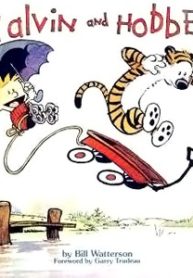Summary
Calvin and Hobbes is a renowned American comic strip created by Bill Watterson, which was syndicated from November 18, 1985, to December 31, 1995. The series chronicles the imaginative adventures of Calvin, a precocious six-year-old boy, and his anthropomorphic tiger friend, Hobbes.



Key Aspects of the Comic Strip:
-
Characters:
- Calvin: A lively and mischievous child with a rich imagination, often embarking on fantastical adventures and adopting various alter egos, such as “Spaceman Spiff” and “Tracer Bullet.”
- Hobbes: To Calvin, Hobbes is a sentient tiger with a sharp wit and sardonic humor. To everyone else, he appears as a mere stuffed animal, creating a unique dynamic that explores themes of imagination and perception.
-
Setting: The strip is set in a suburban American neighborhood, providing a backdrop for Calvin’s daily escapades and interactions with his family, friends, and school life.
-
Themes: Watterson delved into various subjects, including the innocence and curiosity of childhood, critiques of societal norms, environmentalism, and philosophical musings, all wrapped in humor and satire
-
Artistic Style: Watterson’s artwork is characterized by expressive characters, dynamic compositions, and detailed backgrounds. He often experimented with panel layouts and visual storytelling techniques, enhancing the narrative’s emotional and thematic depth.
-
Cultural Impact: At its peak, “Calvin and Hobbes” was featured in over 2,400 newspapers worldwide. The collected editions have sold millions of copies, and the strip continues to be celebrated for its timeless humor and insightful commentary.
-
Merchandising Philosophy: Watterson was notably protective of his creation, refusing to license the characters for merchandise. He believed that commercialization would compromise the strip’s integrity, making “Calvin and Hobbes” one of the few comic strips not to be transformed into a wide array of consumer products.
The final strip, published on December 31, 1995, depicted Calvin and Hobbes embarking on a sledding adventure, symbolizing the endless possibilities of imagination. Watterson’s decision to conclude the series at its peak ensured its enduring legacy as a masterpiece of comic art.


